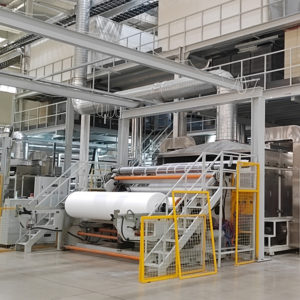The dimensional stability of spunbonded polypropylene refers to its ability to maintain its original shape, size, and structural integrity over time and under varying conditions.
Several factors influence its dimensional stability:
- Temperature Stability: Spunbonded polypropylene generally has good resistance to temperature variations. It retains its shape and properties within a broad temperature range, remaining dimensionally stable under normal operating conditions.
- Moisture Resistance: It exhibits excellent resistance to moisture, retaining its structure and dimensions even when exposed to humidity or moisture. This property is advantageous in various applications where moisture stability is essential.
- Chemical Resistance: Spunbonded polypropylene is resistant to many chemicals, which helps maintain its dimensional stability when exposed to a range of chemicals or harsh substances.
- Tensile Strength: Its high tensile strength contributes to dimensional stability, preventing stretching or deformation even when subjected to stress or load.
- Creep Resistance: Spunbonded polypropylene resists creep, meaning it can maintain its shape and dimensions when subjected to continuous stress or load over time.
- UV Stability: UV resistance can affect dimensional stability. While polypropylene has good resistance to UV radiation, prolonged exposure to intense sunlight might affect its long-term stability.
- Manufacturing Quality and Process Control: Proper manufacturing processes and quality control measures during production contribute to better dimensional stability, ensuring consistent properties and structure.
- Environmental Factors: Factors like prolonged exposure to extreme temperatures, high humidity, or harsh chemicals beyond its resistance level might impact its dimensional stability over extended periods.
- Fabric Structure and Thickness: The specific structure and thickness of the spunbonded polypropylene fabric play a role in its dimensional stability. Different constructions might exhibit varying levels of stability.
- End-Use Conditions: The conditions under which spunbonded polypropylene is used or stored influence its dimensional stability. Proper storage and usage according to manufacturer guidelines help maintain stability.
Overall, spunbonded polypropylene tends to exhibit good dimensional stability under normal operating conditions, making it suitable for a wide range of applications where maintaining shape and size is crucial. However, like any material, its long-term stability can be influenced by environmental factors and usage conditions. Proper handling, storage, and adherence to recommended usage guidelines can help maximize its dimensional stability over time.
How does the surface treatment of spunbonded polypropylene affect its functionalities?
Surface treatment of spunbonded polypropylene can significantly impact its functionalities and performance in various applications.
Some effects of surface treatments include:
- Enhanced Hydrophobic or Hydrophilic Properties: Surface treatments can render spunbonded polypropylene more hydrophobic (water-repellent) or hydrophilic (water-absorbent), depending on the intended application. Hydrophobic treatments are suitable for moisture-resistant applications like packaging or outdoor textiles, while hydrophilic treatments are useful in medical or hygiene products.
- Improved Adhesion: Surface treatments can enhance the fabric’s ability to adhere to other materials, making it more compatible for lamination or bonding processes in composite materials or multilayer products.
- Antimicrobial or Antistatic Properties: Treatments can impart antimicrobial or antistatic properties, making the fabric resistant to microbial growth or reducing static charge buildup. This is valuable in medical, spun bonded polypropylene hygiene, or electronic applications.
- Enhanced Printability: Surface treatments can improve the printability of spunbonded polypropylene, allowing better ink adhesion and color retention for applications requiring printing or customization.
- Flame Retardancy: Surface treatments can confer flame-retardant properties to the fabric, making it suitable for applications where fire safety is critical.
- UV Resistance: Some treatments enhance the fabric’s UV resistance, prolonging its lifespan and preventing color fading or degradation when exposed to sunlight.
- Dyeability and Color Fastness: Surface treatments can improve dyeability and color fastness, allowing better dye penetration and retention of vibrant colors in dyed fabrics.
- Oil and Stain Resistance: Treatments can make spunbonded polypropylene more resistant to oil, stains, or dirt, increasing its suitability for applications requiring easy cleaning or stain resistance.
- Softness and Hand Feel: Certain treatments can modify the fabric’s texture, making it softer or altering its hand feel, which can impact consumer preferences in various applications.
- Environmental Impact: Some surface treatments aim to improve the environmental footprint of spunbonded polypropylene by enhancing biodegradability or recyclability.
Surface treatments are tailored to specific applications and can be customized to achieve desired functionalities, making spunbonded polypropylene more versatile in meeting diverse industry needs. Proper selection of surface treatments is crucial to optimize the fabric’s performance while maintaining its core properties.

